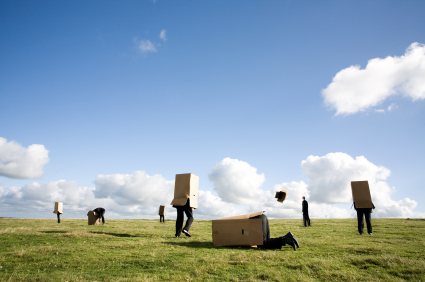Self storage: Thinking inside the box

Storage boxes are what most people use to store their stuff in self storage units. Plain cardboard boxes – it’s as simple as that. But the cardboard boxes that are sold at self storage facilities come at a price. Are they worth it?
Bespoke self storage boxes
Bought cardboard boxes have several major advantages:
- they are well made and strong;
- they come flat-packed, so are easy to transport when empty;
- they come in standard sizes, so can be stacked neatly in your storage unit.
Typically, standard cardboard storage boxes come in three sizes: small, medium and large. These sizes vary from company to company, but are approximately:
Small: w335 x d255 x h355mm
Medium: w405 x d405 x h405mm
Large: w457 x d457 x 550mm
Boxes are always measured in metric, but of course self storage units are usually quoted in square feet. To give you an approximate idea, a small box of the above size has a base that covers just under one square foot, and the medium box covers nearly two square feet.
Bought boxes are relatively expensive, costing somewhere between £2 and £4 each; they are cheaper if bought in multipacks of, say, 15 or 20. Still, a pack of 20 medium boxes could cost £56.
Supermarket boxes
…which is why you may well be able to save yourself a healthy sum of money by using (reusing, or recycling) commercial cardboard boxes. Many supermarkets and some wine stores are happy for you to take away their empty boxes.
Choose strong ones. Wine boxes can be strong, but boxes used for shipping spirits (whisky, gin, vodka) are usually larger and stronger. In a supermarket, look out for fruit boxes, particularly banana boxes.
Also, choose boxes that are in good condition. They have got to be able to bear the tasks of being filled with heavy items, transported and stacked. Note also that you can always make a cardboard box stronger by sealing the joints with packing tape.
There are several disadvantages of using recycled boxes:
- they tend to vary in size;
- they don’t come flat-packed, so take up space when empty;
- it is not always easy to gather a large quantity of boxes quickly: you may need to build up a stock over time.
Archive and wardrobe boxes
Storage companies sell cardboard boxes specially designed for archive storage – office files and so on. They are strong, have lids you can lift right off, and have handles pierced in the sides.
Wardrobe boxes are tall, cardboard boxes in which you can hang clothes on a rail. They cost some £9 to £12.
Plastic boxes
Some storage companies also sell plastic boxes. These are strong, and lidded, and can range in size from small to very large indeed. They are usually measured in litres, from 3 litres (w254 x d180 x h160mm) to 18 litres (w480 x d390 x h200mm), and all the way up to 84 litres (w710 x d440 x h380mm). Prices rise through the range from about £3 for the smallest to £20 for the largest.
Advice about packing
The three most important rules for packing cardboard boxes are:
- Wrap fragile items carefully, to protect them from knocks and spills in transport and at the storage unit.
- Fill the box to the brim if you are going to put another one on top in storage, otherwise the cardboard sides will buckle.
- Don’t load a large box with too many heavy items. You won’t be able to lift it!
2 Responses to “Self storage: Thinking inside the box”
Leave a Reply
Subscribe to This Blog
Get new blog posts sent to you by subscribing to RSS updates or to email updates.







The advantage of committing to a Self Storage Unit is the fact that, rather than forcing furniture into a Uhaul or hiring a company to throw your precious belongings around, you get your own storage space PLUS the comfort of knowing its in a safe environment with no chance of destruction.
Storage fits so many life situations. With more and more people getting on the property ladder later on in life, space in the family home becomes even more important.
Storage solves this problem.